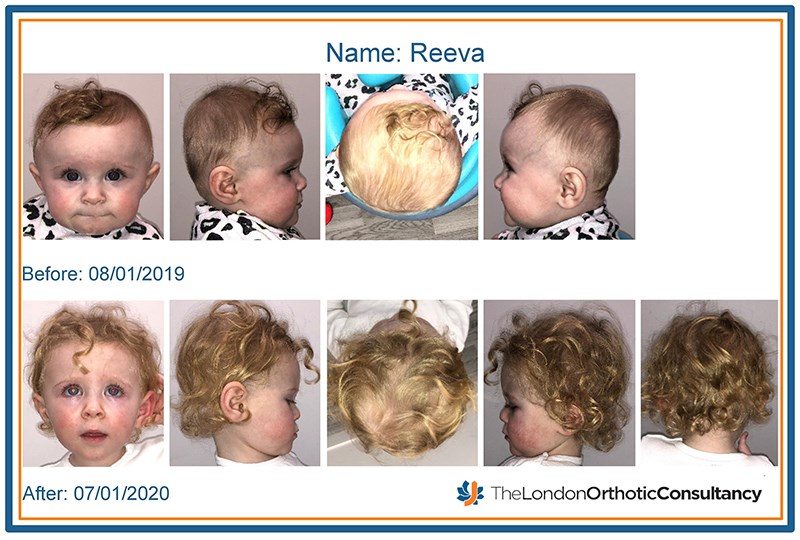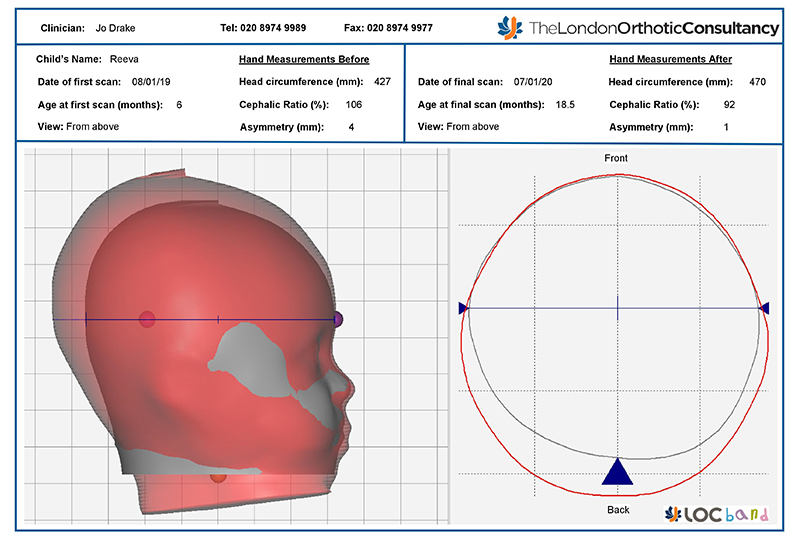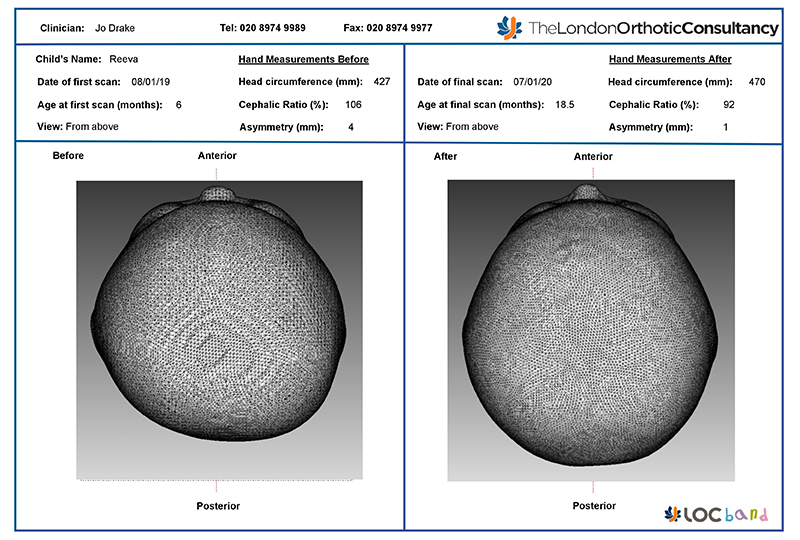
28 February 2020
Like many parents who notice that their newborn’s head shape isn’t quite right, Olivia was in a quandary about what to do. Her daughter, Reeva, had been born by emergency Caesarean section following three days of labour in which she had been in the back-to-back position. As a consequence, Reeva’s head had been pushed out of shape. “It looked a bit cone-shaped,” says Olivia, “but I just assumed that was from where she’d got stuck during labour and didn’t think anything of it at first.”
However, as time went on, Olivia realised that Reeva’s head wasn’t settling back into a ‘normal’ shape. “I struggled to try to correct it myself with tummy time and pillows, but as she got bigger, it just kept getting more obvious that it was flat at the back and sloped up slightly from the forehead to the crown,” she says.
Although she was assured that Reeva did not have anything medically wrong with her, Olivia began to grow concerned about how her daughter’s head shape might adversely affect her in the future. Would she be able to wear a bicycle helmet, or have her hair tied back without feeling self-conscious? Would other children tease her?
Olivia had read about a condition called ‘flat head syndrome’ and began doing some internet research on possible treatments. It was then that she came across LOC. “It said on the website that you could send in pictures and that they would give you a free consultation if they thought you should come in,” says Olivia, who filled in the form and sent in photos straight away. “They emailed me back very quickly, offering to make an appointment for an assessment.”
Reeva was seen at our Kingston clinic by Orthotist Jo Drake, who took measurements of the little girl’s head and diagnosed her with brachycephaly, a condition where the rear of the skull appears flat. It occurs when there is a restriction to growth at the back of the head resulting in flatness and an increase in the width of the head to accommodate the growth of the brain. Although brachycephaly can be congenital (meaning it exists before birth), in Reeva’s case, its cause was more likely position-related, as a result of her complicated birth.
The optimal age for beginning treatment is between four and seven months when the skull is still soft and the cranial plates haven’t yet fused. Reeva was first scanned at six months, so there was no time to lose - especially as her case was very severe with a cephalic ratio of 106%.
“We consider 89% to be the top end of normal, with anything up to 94% classed as moderately severe,” explains Jo. “So, Reeva’s head was wider than it was deep, making it very noticeable visually.”

"Jo recommended fitting Reeva with one of our cranial remoulding helmets called the LOCband, which works by applying gentle, constant pressure over the areas of the baby’s skull that are most prominent while allowing unrestricted growth over the flattened areas. “We were in two minds at first,” says Olivia, who was worried about how Reeva would cope, both physically and emotionally, with wearing a helmet for 23 hours a day. “But, when we talked to Jo and weighed up the pros and cons, we decided to go ahead with the treatment. We knew it wasn’t going to improve by itself.”
Opting for treatment is a big decision for parents, says Jo, although improvements almost always occur quickly after the LOCband is fitted. “Once we get past fitting and the first review a week later, things start to feel a little more relaxed for the parents.”
Luckily, Reeva adjusted to her new helmet with ease. “She loved it,” says Olivia, who decorated Reeva’s helmet with stickers and feathers to make it more cheerful. “She called it her ‘hat’.”
Reeva began wearing her helmet in January 2019, making regular visits back to LOC for check-ups. She rapidly showed improvement at the start with her CR dropping 5% in the first 6 weeks. After this, things slowed down, losing 1% here and there, which is normal at the age she had reached. Following Jo’s advice, Reeva’s parents decided to keep going with the treatment. By December 2019, Reeva’s head was showing signs of hardening, meaning the window for any further manipulation of her skull was closing in, so the decision was made to remove her helmet.
Her most recent scan, in January 2020, revealed that Reeva’s CR is now 92%, a marked decrease from her original reading. Although this figure is still above what is considered normal, Reeva’s appearance has dramatically improved, as shown in her cephalic ratio reducing from 106% to 92% afterwards. “I always like to try and correct the head shape into the normal range but, given the level of severity that Reeva started at, that was always going to be difficult,” says Jo. “By the end of treatment, she had a nice curve to the back of her head, and this will possibly improve a little further naturally in the next few years. Reeva has had a brilliant result.”

Olivia agrees: “Jo was more than happy for us to finish the treatment there because it was as good as it was going to be visually. And we cared more about Reeva’s future confidence than the numbers.”
Olivia is delighted with the results and could not be happier with every step of the treatment process at LOC. “Right from the beginning, we got the answers that we were looking for and left the clinic knowing what we were going to do. Everything just felt really simple every time we went for an appointment,” says Olivia, adding: “I would definitely recommend LOC to other parents, and if anyone is in doubt about whether they should go for treatment, I’d say take advantage of the free consultation, because it was so worth it to go and get confirmation. I’m so happy I did it.”
If you are concerned that your baby has a brachycephaly head shape, we can provide you with our clinical opinion based on your photographs. Just fill in our flat head diagnosis form. Or contact LOC for more information or to make an appointment.
This is very much dependent on how fast your baby is growing. The faster the growth, the more frequently your baby will be seen so that the helmet can be adjusted. In general, reviews will happen at two to four-week intervals.
The price of treatment covers:
Yes - All babies that have completed their course of treatment with us have achieved a measurable improvement in head shape. However, you don’t have to take our word for it.
Recent independent research conducted by a University Hospital in Germany has endorsed the treatment for babies with moderate or severe plagiocephaly.
A larger, retrospective study has just been published that found complete correction was achieved in 94.4% of babies treated with helmet therapy.
The results were conclusive: repositioning achieved acceptable correction in 77.1% of cases, but 15.8% were moved onto helmet therapy because re-positioning was not working. Meanwhile, 94.4% of the infants who started in the helmet-treated group achieved full correction, as did 96.1% of those who were transferred from the repositioning group into the helmet-treated group.
Further information can be found on our Plagiocephaly Research page.
If your baby has a temperature or a fever due to illness you must remove the band. The band can be put back on once the temperature has returned to normal.
The optimum age for treatment is between four and seven months.
This is because the skull is most malleable at this age and improvements to head shape tend to take less time and are more dramatic. That is not to say that helmet therapy should be ruled out if the baby is older than seven months. Routinely, babies up to the age of 16 months can be treated very successfully.
The cut off age is around 18 months when the fontanelles (soft spots on the head) are no longer malleable. As babies grow and develop at different rates, it is always worth checking if you are not sure. There have been cases where a baby’s fontanelles have not fused yet by the age of 18 months, who have achieved successful, but less-marked results with cranial remoulding therapy.
Torticollis is a condition in which a tight or shortened muscle in one side of the neck causes the head to tilt or turn to one side, resulting in the infant resting its head in the same position. In 2013, we analysed the data from all first appointments in our Kingston clinic and found that 20% of the babies examined had some kind of neck condition that was causing head immobility.
The clinics and clinicians that provide this treatment in the UK will have received similar training and experience. However, we are the only clinic that manufactures its own helmet and our clinicians are closely involved with the process for each individual helmet that we produce.
In addition, we do not restrict review appointments to a set number, we are extremely flexible and respond to individual parents' needs so that the best outcome can be achieved for each baby.
The LOCband is non-invasive and works by applying gentle, constant pressure over the areas of the baby’s skull that are most prominent while allowing unrestricted growth over the flattened areas. The band consists of a soft foam layer inside a thermoplastic shell. As the baby grows, the band will be adjusted frequently to gently guide the skull into a more symmetrical shape.